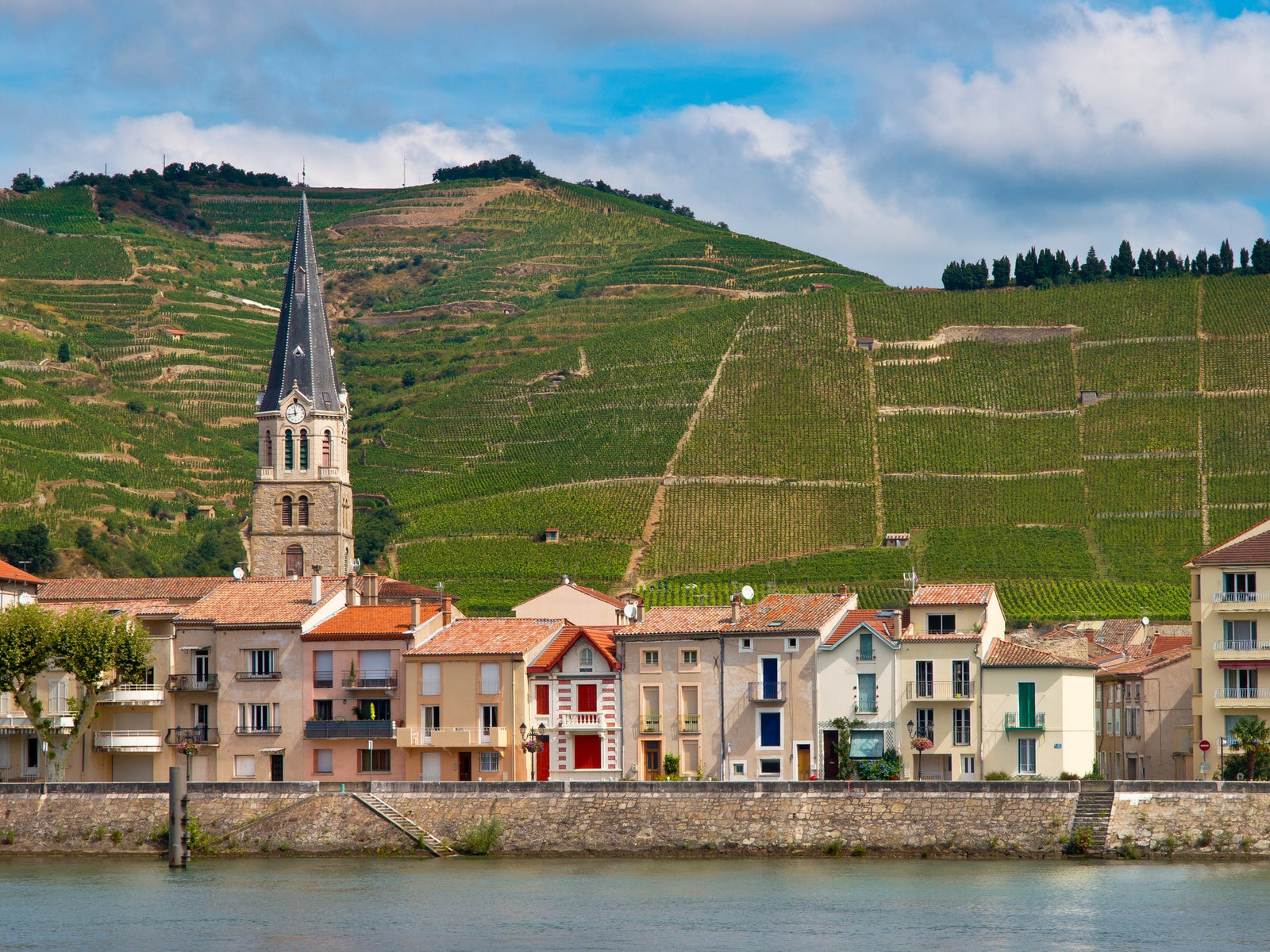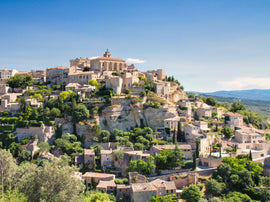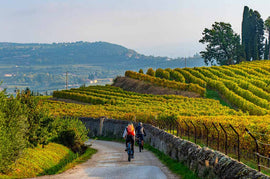In the wine world, sometimes it seems like all roads do, in fact, lead to Rhône. Named for the Rhône river, which flows for 500 miles from the Swiss Alps to the Mediterranean, the Rhône Valley wine region begins in central France, just south of Lyon and follows the water’s path to the sea. Its 150 miles encompass 70,000 hectares under vine across more than 30 different AOCs. Syrah starts here, and at least two dozen other grapes are generally identified as ‘Rhône varietals.’ Rhonê is also responsible for pioneering all kinds of blends, most famously Grenache/Syrah/Mourvedre or GSM, and winemakers the world over - California’s Rhône Rangers for instance - have taken inspiration from the region and sought to echo the power and complexity of its best wines on compatible terroir.
Greek settlers planted the first vineyards in Rhône around 400 BC, near present day Marseilles, but it was their Roman successors who laid the groundwork for widespread viticulture in the area. A thousand years later, Pope Clement V moved the Roman Catholic papal seat from Rome to Avignon, and legend suggests that a knight returning from the Crusades built a small chapel on a hill overlooking the river. The “Castle of the Popes” and the small pilgrim’s chapel today stand as respective and enduring symbols for two of the Rhône’s greatest wines, Châteauneuf-du-Pape and Hermitage.
The former is located in Southern Rhône, the latter in the North - and this bifurcation, North and South, is the most general way the area is divided, as the two parts present a sharp contrast: Northern Rhône is precise and compact, composed of 8 AOCs nestled into 40 miles of steep hillside overlooking the river, and responsible for just 5% of all Rhône wine. Syrah is the only allowable red grape in the region and is grown (along with a minuscule amount of white, mainly Viognier, most notably in the Condrieu AOC) in a cool continental climate, with significant seasonal temperature shifts. Southern Rhône on the other hand, is sprawling and amorphous. As the Rhône river passes Montélimar, the valley flattens and widens and the climate becomes Mediterranean - hot and dry but still heavily influenced by the mistral winds from the Alps. Vineyards begin to take up more of the landscape, extending out from the river banks to encompass much of the surrounding area. There are 12 white and 14 red varietals allowable in Southern Rhône wines, ranging from the near ubiquitous Grenache (Blanc and Rouge) to the almost non-existent Calitor and Picardan.
This month we are featuring a selection from each area, both by women winemakers with viticultural roots going back at least three generations in the region. The white is one of the relatively few produced in Northern Rhone, from the Crozes-Hermitage appellation, the largest in the north, 85% of which is planted to Syrah grapes, with the remaining 15% consisting of the white Marsanne and Roussanne varietals. Christelle Betton sticks to the single varietal tradition with this 100% Marsanne bottling, from a single parcel of 30 year old vines.
The red is a Cotes-du-Rhone blend by Stephanie Fumoso from 55 year-old, organically certified (mostly) Grenache vines planted in the communes of Vacqueyras and Voiles. Full bodied, slightly floral, with great spice and smooth tannins, it’s an ideal coldest-winter-I ever-spent-was a- summer-in-SF red.
Cheers,
PlumpJack Wine Team
|
Domaine Christelle Betton Crozes-Hermitage Blanc ‘Elixir’ |
|
|
Region / Country of Origin: Crozes-Hermitage, Northern Rhone, France |
About the winemaker: Representing the third generation of her family to have answered the siren call of northern Rhône Syrah, Christelle Betton’s vision is one of pure and refined fruit, inspired by the cool northern Mistral winds and stony personality of her family’s vineyards in La Roche de Glun. Her skills come naturally, having watched her grandfather and father care for their vines, plowing the fields by hand and farming as naturally as possible. Today Christelle farms her land organically, but is not certified; she prefers the flexibility of allowing the earth to tell her what it needs, and when. About the winemaking: A selection of fruit from a single parcel planted in 1985. Soils are alluvial with many “galets roulés” commonly found along the Rhône River valley (especially in Châteauneuf-du-Pape). The area is dry; the family plows their land by hand to train the vines’ roots to dig deep in the rocky soils for nutrients and moisture. Hand-harvested. Pressed directly; fermented in tanks on indigenous yeasts. Aged in tanks for eight months. Tasting Notes: Aromas of white flowers, citrus zest, light spice, crisp pear. Good volume, balanced; clean finish. |
|
Winemaker: Christelle Betton |
|
|
Price: $26.99 btl/$291.50 case |
|
|
Suggested Food Pairing: As an aperitif; with soft rind cheese; grilled chicken; air-dried sausages |
|
|
Gour de Chaulé Côtes du Rhône Rouge "La Vigneronne" 2021 |
|
|
Region / Country of Origin: Gigondas, Southern Rhone, France |
About the Winery: The Domaine Gour de Chaulé, situated in the heart of the village of Gigondas, was founded in 1900 by Eugene Bonfils, the great-grandfather of the current proprietor Stephanie Fumoso. All the wine produced at the estate was sold in bulk to negociants until 1970 when Madame Rolande Beaumet, Eugene’s daughter and Stéphanie’s grandmother, began to bottle a small percentage of the estate’s wine for sale to private clients. Madame Beaumet’s daughter, Aline Bonfils, ascended to the head of the domaine in the early 1980s and it was under the direction of Aline that the tradition of estate bottling expanded significantly. The domaine comprises 15 hectares, 10 of which are within Gigondas with the remaining 5 hectares situated in the surrounding communes of Vacqueyras and Violes. About the winemaking: Dedicated to minimal intervention in the vineyards and winemaking. It is vinified in a similar fashion as the Gigondas except that the élevage is shorter. This is to say that there is an extended cuvaison with stems included, malolactic fermentation occurs, and the wine sees a stay in large foudres (30%) and concrete eggs (70%) before being bottled 18 months after harvest without fining or filtration. Tasting Notes: The aromas are quite pretty, showing ripe cassis, strawberry and black cherry with hints of violet, spice and garrigue. The palate shows peppery ripe fruit, cassis, black plum and strawberry, with earth, spice and tobacco. |
|
Winemaker: Stephanie Fumoso |
|
|
Price: $24.99/btl $269.90 case |
|
|
Suggested Food Pairing: Herb-crusted chicken thighs; barbecue pork with a berry-flecked, herbaceous sauce; lamb chops with lentils du Puy |
|





